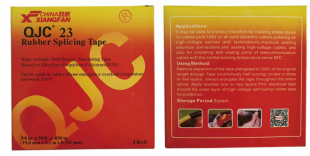The Versatility and Importance of Insulating Tape
Insulating tape, also commonly known as electrical tape, is an essential tool in various industries, particularly in electrical applications. Its significance often goes unnoticed until the moment an electrical connection needs protection or repair. Made from materials that can easily withstand high temperatures and resist environmental factors, insulating tape plays a crucial role in ensuring both safety and durability in electrical systems.
One of the primary functions of insulating tape is to prevent electrical short circuits. When wires are exposed, the risk of a short circuit increases significantly. Insulating tape provides a protective barrier that shields wires from potential contact with conductive materials or other wires. This is vital in reducing the risk of electrical fires, which can occur when circuits become overloaded or when there is a failure in insulation.
Apart from preventing short circuits, insulating tape is also used to enhance the insulation of existing wiring. Over time, insulation can become worn or damaged, exposing the conductive wire. A few wraps of insulating tape can effectively restore protection, prolonging the life of the wires and maintaining the integrity of the electrical system. This simple solution can save costly repairs or replacements and is a common practice in both residential and commercial settings.
Insulating tape is not limited to its use in electrical systems
. Its versatility extends to various applications, including automotive repairs, home improvement projects, and even crafting. In automotive contexts, for example, insulating tape is used to secure and insulate wiring, ensuring that electrical systems function smoothly and safely. In home projects, it can be used to bundle and organize wires, providing a cleaner and more organized appearance while preventing potential hazards.insulating tape

Another advantage of insulating tape is its ease of use. Unlike traditional adhesives that may leave a sticky residue or require specific conditions to bond, insulating tape is straightforward to apply. It adheres quickly to surfaces and can be easily repositioned if necessary. Additionally, it comes in various colors, which can aid in organizational tasks or indicate specific functions within a wiring system, making it a practical choice for both professionals and DIY enthusiasts.
When selecting insulating tape, it is essential to consider factors such as temperature resistance, thickness, and material. PVC (polyvinyl chloride) is a commonly used material that offers good insulation properties and flexibility, making it ideal for a wide range of applications. For high-temperature environments, consider tapes specifically designed to withstand extreme conditions, as these will provide reliable performance while minimizing the risk of damage.
Despite its unassuming appearance, insulating tape is a vital component in the world of electronics and beyond. Its role in enhancing safety, protecting electrical systems, and enabling a range of practical applications is critical. Whether you are a professional electrician, an automotive technician, or a DIY hobbyist, keeping a roll of insulating tape on hand can prove invaluable for preventing issues and ensuring efficient, safe operations.
In conclusion, insulating tape is more than just a simple tool; it embodies reliability and versatility across various fields. From safeguarding electrical connections to assisting in creative projects, its applications are numerous and essential. Understanding its importance can help individuals appreciate the role of such a practical item in enhancing safety and efficiency in our everyday lives.
-
XIANGFAN Rubber Tape-Ultimate Solutions for All Your Insulation NeedsNewsJun.24,2025
-
XIANGFAN Rubber Tape-Protection for Industrial and Residential ApplicationsNewsJun.24,2025
-
XIANGFAN Rubber Tape: Superior Safety and Sealing for Demanding EnvironmentsNewsJun.24,2025
-
XIANGFAN Rubber Tape: Reliable Solutions for Every Electrical ChallengeNewsJun.24,2025
-
XIANGFAN Electrical & Industrial Tape: Powering Reliability Across IndustriesNewsJun.24,2025
-
XIANGFAN Electrical & Industrial Tape: Excellence in Every ApplicationNewsJun.24,2025
